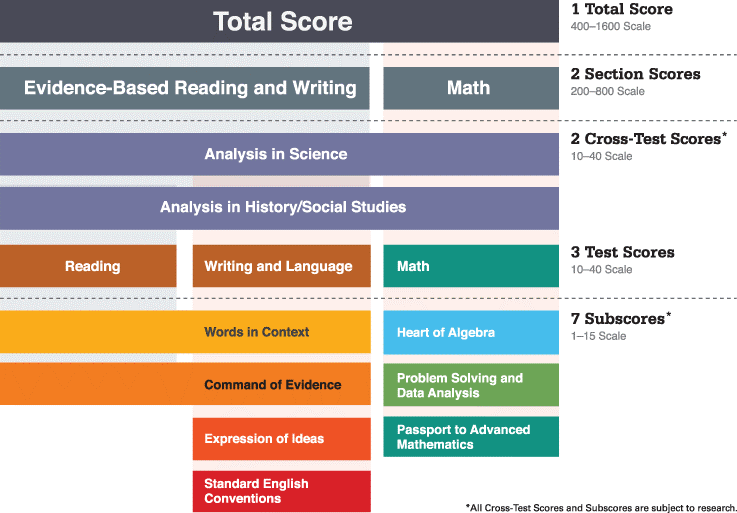Should I take the ACT or the SAT? This is one of the most common questions students have when they begin to consider the college application process.
A Brief Review of the New SAT
 Three little letters: SAT.
Three little letters: SAT.
For many years now, those three little letters have evoked feelings of dread, fear and anxiety in the minds of countless high school students across the country. We are speaking of course, of the Scholastic Aptitude Test. It is a standardized exam offered by the College Board used in determining college admissions and, in many cases, scholarships to a given institution. The ACT (American College Testing) is also offered and accepted at all four-year institutions just like the SAT.
As many of you may know, the SAT has been around for quite some time now, with the first test being administered on June 23, 1926. To this effect, for the first time in 11 years, the writers of the exam figured it was time their exam was updated and thus, the newly reformatted SAT hit test-takers desks March 2016 for the first time.
This article will give you the full scoop on this new exam, its structure and breakdown, and more specifically, what you need to do differently to make sure you succeed on this new test.
The first thing you probably want to ask yourself with this test just being released last month is, “does this even apply to me?” That’s a great question. This depends on when you are applying to college and if the SAT is the right test for you. It is popular with schools on the East and West Coast as well as many private institutions. If you’re shooting for the Ivy League, this test is definitely preferred in coast schools. But remember, all 4-year institutions take both the SAT & the ACT. If you are applying to college in the Fall of 2016 or later, then you can utilize the new SAT! Now, that said, what if you want to use your old scores? Well, are you currently a junior in the class of 2017? Don’t worry! Old and New SAT scores will be accepted for the class of 2017. This is likely because the exam switched halfway through the year.
There’s a small catch though. Many students like to call this score adjustment tactic colleges use “Superscoring” where colleges use multiple exams and pick out the best score in each section, assembling a “superscore” that is the highest from each section, thus raising your composite score higher than any one complete exam. This will NOT occur between the new and old testing and scoring formats since they are different exams that are scored differently. Okay, so if you’re currently a junior graduating in 2017, you’re fine using your old SAT scores to apply. If you’re in the class of 2018 however, I strongly urge you to check with your colleges because there’s at least one Chicago school that has officially stated they will not accept old SAT scores for their class of 2018. Northwestern University has officially stated they will not be accepting the old SAT for the class of 2018 and beyond. So the moral of the story is: if you’re graduating in 2018, check with your institutions of choice if they will be requiring the new exam scores.
But what about the actual test? What changed? Is it harder or just different? And, of course, everyone’s concern: Scoring! Let’s delve a little deeper into what changed and the structure of this new exam.
Time for some good news: the new SAT has been getting good reviews from test-takers everywhere! Students are saying that the new exam is more straightforward, less ambiguous, and contains less strange vocabulary words. I know at least for me that would be a huge relief were I to take this exam again since it definitely had the uncanny knack of throwing some crazy words at me. The test will still test the same subject areas (Reading, Writing & Math), however, now the reading and writing sections are termed “Evidence-based Reading & Writing”. The idea is this new content will better analyze ones skills in acquiring information and making quality decisions using that evidence-based information given.
Another big relief to students is that the essay portion is now 50 minutes long and optional. Students should check with their individual and prospective institutions to see if they require the SAT with Essay or without. Test makers insist that the multiple-choice section of the test “deeply predicts” one’s academic success in college while many institutions did not find the written portion as helpful as a predictor. If you choose to opt for a test with an essay, the structure of the exam is very similar to the previous exam and will run about 3 hrs and 50 min (compared to the old exam which was 3 hours and 45 minutes). If you opt-out of the essay, then your exam will run you only 3 hrs. There is continued emphasis on reasoning like the older exam, while taking a new approach to focus more comprehensively on skill, knowledge and understanding of those imperative skills for college readiness. Thus, after what seems to be lots of deliberation and research, the new SAT is claimed to be a far better predictor than the old one! There is still one last element that underwent a major change, and this element is arguably the most important one to all the students reading this paper: Scoring.
The new SAT is scored much differently than its older counterpart.
Instead of being out of 2400 points, this exam offers a total of 1600 points split between the “Evidence based Reading & Writing” and Math sections, each 800 points. Like before, the worst you can do on each individual section is to get a score of 200 making the lowest possible score 400. However, one very exciting element of this new test is their new guessing penalty…or rather, their lack thereof! The new SAT does not penalize you for guessing. Incorrect or blank answers do NOT result in any points lost. This does mean one very important strategy change: Answer everything! Make sure every last bubble on that exam is filled in because no guessing penalty means if you don’t answer a question you miss out on a perfectly good chance to get points without the risk of losing any if you’re wrong. Previously, you were cautioned against guessing due to the older exam deducting points for wrong answers. This time however, go for it and make sure you leave enough time at the end to answer all of them.
Figure 1 at the end of this article is provided by the college board and details very colorfully, the individual score/subscore breakdown of the content on the SAT. Please reference it for further analysis of what will be on the exam and how it will be organized.
The final note I will make on this subject of the new SAT is that the most important factor in preparing for the exam has not changed: you gotta practice, practice, practice! The way to achieve the best score possible is to take as many practice exams as you can. To take these exams, you need to build up your skills and familiarity with the exam so you are ready to constantly get in the ring and battle it. Like a boxer training for his big fight, this exam can make a big impact on your application. MyGuru offers unique insight into test prep services and studies show that one on one time with a tutor during test prep can truly make an extraordinary difference. Study hard and keep your eye on the prize, that’s the recipe for success!
Figure 1: New SAT Score Breakdown: Breakdown shows the Analysis in Science & History/Social Studies will expand over both sections, thus their scoring is termed “cross-test scores”. Subscore section details the specific concepts that are evaluated in each section.

Image Credit: https://collegereadiness.collegeboard.org/educators/higher-ed/scoring-changes/new-score-structure
